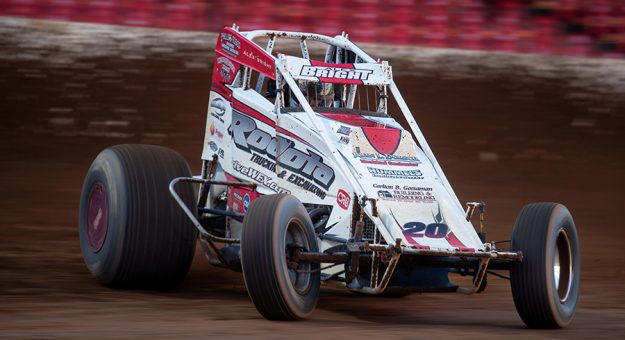The fact that Alex Bright captured the 2021 USAC East Coast sprint car title was unsurprising. After all, it was Bright’s third championship in a five-year span and he has repeatedly shown the ability to go toe-to-toe with the best in midget and sprint car racing in this country and abroad.
The fact that Alex Bright captured the 2021 USAC East Coast sprint car title was unsurprising. After all, it was Bright‘s third championship in a five-year span and he has repeatedly shown the ability to go toe-to-toe with the best in midget and sprint car racing in this country and abroad.
However, from the first moments of his career, Bright has demonstrated a restless streak that is anathema to the behavior required to sit atop a points chart. It seems success has always motivated him to search for a fresh challenge.
As a generational phenomenon, most top-flight, open-wheel racers have the sport burned deep in their bloodlines. Bright is no exception. It begins with his grandfather. In the 1930s, Jack Bright was raced big cars. On June 16, 1935, Bright signed in at the fearsome Langhorne (Pa.) Speedway for a Pappy Hankinson-promoted 50-mile event.

The track called the “Big Left Turn” was not for the faint of heart, a reputation made clear when the land between turns one and two became known to all as Puke Hollow. Charles Hildebrand crashed through the inside guardrail and was killed. While Bright survived the day, he was injured when his car also crashed through the fence.
In 1936, he made his way to Indianapolis Motor Speedway in hopes of landing a ride. While Bright fell short of his ultimate goal, he ended up on the starting grid as a riding mechanic for Ted Horn.
Through his father‘s stories, Ted Bright explained, “There apparently was a lack of chemistry between Horn and his riding mechanic and my dad was in the right place at the right time.”
Although Alex Bright was very young when his grandfather relayed the story of the 1936 Indy 500, it still captures his imagination.
“I guess they should have won that race, “Alex says, “Back then their fuel gauge was just a clear line that went through the dash and once they started seeing bubbles going through it, they knew they had to stop and pit. I guess they had a leak in the line. So they went in and got fuel, but after the race they realized that they could have stayed out.”
Horn and Jack Bright finished second, while Louie Meyer became the first to win three Indianapolis 500s and became the first driver to receive the Borg-Warner trophy. Additionally, an exhausted Miller requested the one drink that he had always turned to quench his thirst in hot weather — buttermilk. The moment he took a big gulp and held up three fingers signifying his historic win a new tradition was born.
Jack Bright became interested in aviation and served as Captain in the Air Corp. during World War II. After the war, he rekindled his interest in racing through friendships with Bobby Marshman, Len Duncan and Ed “Dutch” Schaefer.
Jack Bright‘s son, Ted, also become a pilot and got his kicks with a parachute on his back. As for racing, he notes with a laugh that his father counselled him “that he would be better served doing something else.”
Nonetheless, the sport crept back into his life after the birth of sons, Alex and Brenden. Alex Bright suggests the family‘s entrance into racing came after his dad “bumped into some people who had kids in quarter midgets.” Looking back, Ted Bright said, “We decided we were going to a club meeting at Phoenixville (Pa.) and they welcomed us with open arms. At the time Alex was 6 and Brenden was 5. I rustled up a couple of old quarter-midget chassis and a friend of mine was building some Honda engines. We got into dirt racing at first and the boys progressed quite nicely.”
After a year or so on the dirt, the Brights gave pavement racing a try with the Doylestown Quarter Midget Club.
Alex Bright shrugs off the importance of his success in the formative days of his career but grudgingly admits he was able to bag a few championships. He stuck with quarter midgets until his 13th birthday, he was ready to take on 600 micro racing.
While father and son were eager to take the next step, age restrictions prevented his participation at Some tracks. The one place where he could compete was Shippensburg Speedway. Luckily, the Brights had struck up a friendship with Pastor Jackie Wilson and his son J.D., and they provided immeasurable support during this transition.
“Whistlin‘” Jackie Wilson had remarkable success in modified racing throughout the Northeast and much like the great Mel Kenyon suffered significant burns in a life-changing accident. Pastor Jackie exertrf a profound influence on Bright‘s career.
It started as a simple friendship but as Ted Bright noted, “He turned into Alex‘s crew chief and mentor and because of that Alex got quite adept at micros and won tons of races.” The raw talent was already there, but it was Wilson who was able to provide that extra something that turned Bright into a winner. “Alex had perseverance and focus,” Ted Bright said. “But Jackie Wilson gave him a lot of confidence. He was ordained and he could preach at the pulpit, and he made sure he did that with Alex. He did a fantastic job and he really helped Alex with his self-esteem.”
Soon the Bright brothers were regularly dueling at the toughest micro tracks in the East. The family was having fun, but with two boys racing, Ted Bright was stretched to the maximum in every way. Thankfully, help was on the way, and it came from a familiar source.
